Archaeology
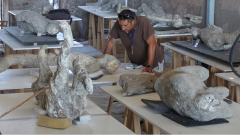
Dec 17th, 2025 - It's quick and easy to access Live Science Plus, simply enter your email below. We'll send you a confirmation and sign you up for our daily newsletter, keeping you up to date with the latest science news. Facebook X Whatsapp Reddit Flipboard Join the conversation Add us as a preferred source on Google Newsletter Subscribe to our newsletter Pompeii may have been unseasonably cold when the eruption of Mount Vesuvius destroyed the Roman city in A.D. 79, new research proposes. A new analysis of 14 ... [Read More]
Source: livescience.com

Dec 16th, 2025 - History from countries and communities across the globe, including the world's major wars. The stories behind the faiths, food, entertainment and holidays that shape our world. Tom Metcalfe A smoked mummy, a Pompeiian banquet room and a Neanderthal fingerprint are among the year's most intriguing discoveries. From ancient Maya kings to Vietnamese mummies to Egyptian pleasure barges, 2025 brought significant archaeological discoveries from all corners of the world. Some were stunning one-offs, ... [Read More]
Source: history.com

Dec 16th, 2025 - Follow Earth on Google A tiny 8,000-year-old stone figurine from Damjili Cave in western Azerbaijan is pushing archaeologists to rethink how farming-era culture reached the South Caucasus. The object looks human but has no clear male or female traits, which makes it what researchers call an asexual figurine. Carved just before permanent farming villages appeared in the region, the figurine sits at the tipping point between mobile hunting life and settled agriculture. Its unusual body ... [Read More]
Source: earth.com

Dec 16th, 2025 - It's quick and easy to access Live Science Plus, simply enter your email below. We'll send you a confirmation and sign you up for our daily newsletter, keeping you up to date with the latest science news. Facebook X Whatsapp Reddit Flipboard Join the conversation Add us as a preferred source on Google Newsletter Subscribe to our newsletter Archaeologists in Egypt have uncovered the remains of a 4,500-year-old valley temple. The structure is part of a sun temple that ancient Egyptians built in ... [Read More]
Source: livescience.com

Dec 15th, 2025 - An Italian archaeological mission has discovered the remains of a sun temple belonging to an ancient Egyptian king near Cairo, the Egyptian antiquities ministry said. The temple of King Nyuserre is believed to be from the Fifth Dynasty and the remains were found in the Abusir necropolis south of the Egyptian capital. It is part of a monumental complex dedicated to the cult of the sun god Ra and is one of the few solar temples identified to date. The site was identified as early as 1901 by the ... [Read More]
Source: cbsnews.com

Dec 15th, 2025 - It's quick and easy to access Live Science Plus, simply enter your email below. We'll send you a confirmation and sign you up for our daily newsletter, keeping you up to date with the latest science news. QUICK FACTS Name: Magdala stone What it is: Carved stone block Where it is from: Magdala Synagogue, Israel When it was made: Before A.D. 70 In 2009, Israeli archaeologists uncovered a massive stone in an ancient synagogue near the Sea of Galilee — and it had an ancient menorah carved ... [Read More]
Source: livescience.com
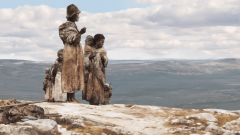
Dec 15th, 2025 - An ancient human lineage roamed Europe's frozen tundra for nearly 80 generations. Then they died out. Some 45,000 years ago, in the frigid reaches of Ice Age Europe, a small band of humans trudged across the tundra, their dark skin warmed by fur-lined cloaks. They hunted woolly rhinos, fashioned distinctive stone tools, and perhaps exchanged stories around fires in caves. A new discovery of ancient genomes brings these forgotten ancestors — and their fleeting presence — into clearer ... [Read More]
Source: zmescience.com
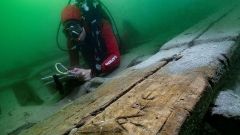
Dec 13th, 2025 - It's quick and easy to access Live Science Plus, simply enter your email below. We'll send you a confirmation and sign you up for our daily newsletter, keeping you up to date with the latest science news. While diving off the coast of Egypt, underwater archaeologists found the 2,000-year-old remains of a boat that may have been a luxurious "pleasure barge" for the ancient elite. The team discovered the barge in the ancient harbor of Alexandria, the capital of Egypt during the Ptolemaic period ... [Read More]
Source: livescience.com
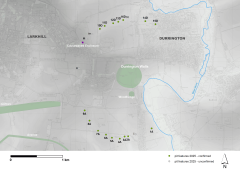
Dec 12th, 2025 - Some massive prehistoric pits were built by human hands. You think you know Stonehenge. The iconic rock towers standing against a green field and a gray English sky are one of the most impressive sights in human history. But that's just the tip of the iceberg. Stonehenge, the monument, was merely the centerpiece of a sprawling, bustling industrial complex of the Neolithic world. Archaeologists exploring the region have uncovered a landscape teeming with life, death, and engineering feats that ... [Read More]
Source: zmescience.com
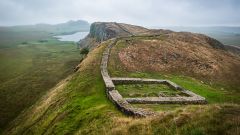
Dec 10th, 2025 - It's quick and easy to access Live Science Plus, simply enter your email below. We'll send you a confirmation and sign you up for our daily newsletter, keeping you up to date with the latest science news. The British northern frontier was the edge of the Roman world — and a place of violence, boredom and opportunity, experts told Live Science. Two millennia ago, the Roman Empire reached the limits of its power in Britain. The island marked the northernmost border of the Roman Empire and ... [Read More]
Source: livescience.com
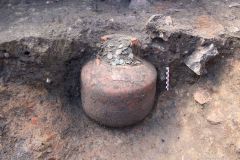
Dec 10th, 2025 - Archaeologists in France found a hidden hoard of Roman coins buried beneath a village with ancient roots. Archaeologists in northeastern France have uncovered an ancient neighborhood beneath the town of Senon, where they found three ceramic jars filled with Roman coins. The hoard is huge, numbering at least 25,000 bronze and copper coins from the 3rd-century CE. The discovery, made during a routine excavation, offers new insight into how people in the late Roman Empire stored and managed their ... [Read More]
Source: zmescience.com

Dec 10th, 2025 - It's quick and easy to access Live Science Plus, simply enter your email below. We'll send you a confirmation and sign you up for our daily newsletter, keeping you up to date with the latest science news. Archaeologists have found the earliest evidence yet of fire technology — and it was created by Neanderthals in England more than 400,000 years ago. Neanderthals were the world's first innovators of fire technology, tiny specks of evidence in England suggest. Flecks of pyrite found at a ... [Read More]
Source: livescience.com
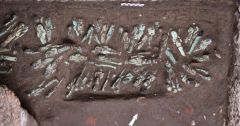
Dec 5th, 2025 - A treasure trove of 225 funerary figurines has been discovered inside a tomb in the ancient Egyptian capital of Tanis in the Nile Delta, a rare find that experts say has also solved a "long-standing archaeological mystery." "Finding figurines in place inside a royal tomb has not happened in the Tanis necropolis since 1946," French archaeologist Frederic Payraudeau told reporters in Paris on Friday. Such a find has also never happened before further south in Egypt's Valley of the Kings near ... [Read More]
Source: cbsnews.com

Nov 4th, 2025 - After two decades and an estimated cost of $1bn, the Grand Egyptian Museum (GEM) opened its doors to the public on Tuesday, just a few days after the official opening ceremony on Saturday. Regarded as the world's largest archaeological facility for a single civilisation, the museum is located 2km (1.2 miles) from the pyramids of Giza and 8km (5 miles) from the capital, Cairo. The complex spans nearly 500,000sq metres (5,381,900sq ft) and will house more than 100,000 ancient artefacts from the ... [Read More]
Source: aljazeera.com
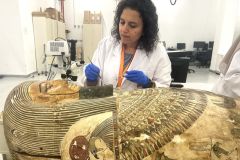
Oct 30th, 2025 - For the first time since the boy king's tomb was discovered in 1922, all the items will stored in one place, a museum director told NBC News. GIZA, Egypt — They're the crown jewels of the Grand Egyptian Museum — two galleries devoted to the ancient pharaoh Tutankhamun . Showcasing more than 5,300 objects from the young king's tomb, including his iconic death mask and glittering royal regalia, the new section of the vast museum here on the outskirts of Cairo is expected to draw ... [Read More]
Source: nbcnews.com
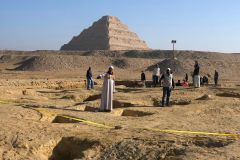
Oct 5th, 2025 - CAIRO (AP) — Egyptian antiquities officials on Sunday said a Pharaonic painting has disappeared from the famed Saqqara necropolis just outside of Cairo, becoming the latest artifact to disappear in a country known for its rich history. Mohamed Ismail, secretary-general of the Supreme Council of Antiquities, said the limestone painting was in the tomb of Khentika in the Saqqara necropolis. The mastaba tomb, which housed the painting, was found in the 1950s, and hasn't opened since 2019, he ... [Read More]
Source: aol.com